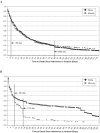Ethnic variation in timing of hospice referral: does having no informal caregiver matter?
- PMID: 18363492
- PMCID: PMC2719542
- DOI: 10.1089/jpm.2007.0149
Ethnic variation in timing of hospice referral: does having no informal caregiver matter?
Abstract
Background: The length of hospice stay, as an indicator of timing of hospice referral, is an important outcome to examine in end-of-life care because it is relevant to the quality and cost efficiency of end-of-life care that patients receive. Although the majority receives nonmedical care from informal caregivers, many elderly hospice users rely on paid caregivers or staff of residential facilities.
Objective: This study examined whether availability of informal primary caregiver interact with ethnicity to affect length of hospice stay.
Design: A retrospective cross-sectional study.
Setting/subjects: Data on 3024 hospice patients aged 65 and older discharged between 1997 and 2000 was extracted from the National Center for Health Statistics' National Home and Hospice Care Survey (NHHCS).
Measurements: Length of hospice stay prior to death or discharge.
Results: Survival analysis revealed that among patients with formal caregivers, minority patients were likely to have significantly shorter hospice stays than non-Hispanic whites. There were no significant ethnic differences in length of stay among patients with informal caregivers.
Conclusions: Our findings suggest that ethnic differences in length of stay should be discussed in terms of type of caregiver, not just type of setting, since patients in residential facilities can have informal primary caregivers who are vigilant advocates for their dying relatives. We discuss possible reasons for the influence of having formal caregivers on length of stay of minority elders.
Figures
Similar articles
-
Formal and informal support of family caregivers managing medications for patients who receive end-of-life care at home: a cross-sectional survey of caregivers.Palliat Med. 2014 Oct;28(9):1146-55. doi: 10.1177/0269216314535963. Epub 2014 May 22. Palliat Med. 2014. PMID: 24854033
-
Caregiver support and place of death among older adults.J Am Geriatr Soc. 2021 May;69(5):1221-1230. doi: 10.1111/jgs.17055. Epub 2021 Feb 15. J Am Geriatr Soc. 2021. PMID: 33590479 Free PMC article.
-
Survival in hospice patients with dementia: the effect of home hospice and nurse visits.J Am Geriatr Soc. 2021 Jun;69(6):1529-1538. doi: 10.1111/jgs.17066. Epub 2021 Feb 19. J Am Geriatr Soc. 2021. PMID: 33608869 Free PMC article.
-
The role of race and ethnicity in predicting length of hospice care among older adults.J Palliat Med. 2012 Feb;15(2):149-53. doi: 10.1089/jpm.2011.0220. Epub 2012 Feb 7. J Palliat Med. 2012. PMID: 22313431
-
How does the timing of hospice referral influence hospice care in the last days of life?J Am Geriatr Soc. 2003 Jun;51(6):798-806. doi: 10.1046/j.1365-2389.2003.51253.x. J Am Geriatr Soc. 2003. PMID: 12757566
Cited by
-
'Palliative care': a contradiction in terms? A qualitative study of cancer patients with a Turkish or Moroccan background, their relatives and care providers.BMC Palliat Care. 2010 Sep 10;9:19. doi: 10.1186/1472-684X-9-19. BMC Palliat Care. 2010. PMID: 20831777 Free PMC article.
-
The Utility of a Connecting Framework to Facilitate Understanding of and Reduce the Disparities in Hospice Care Experienced by Racial and Ethnic Minorities.Prim psychiatry. 2008 Oct;15(10):38-44. Epub 2008 Oct 1. Prim psychiatry. 2008. PMID: 29033533 Free PMC article.
-
Are Trends in Hospitalization Prior to Hospice Use Associated With Hospice Episode Characteristics?Am J Hosp Palliat Care. 2017 Nov;34(9):860-868. doi: 10.1177/1049909116659049. Epub 2016 Jul 14. Am J Hosp Palliat Care. 2017. PMID: 27418598 Free PMC article.
References
-
- Medicare Payment Advisory Commission . Report to the Congress: New Approaches in Medicare. MedPAC; Washington, D.C.: 2004. Hospice care in Medicare: Recent trends and a review of the issues.
-
- Miller SC, Mor V, Teno J. Hospice enrollment and pain assessment and management in nursing homes. J Pain Symptom Manage. 2003;3:791–799. - PubMed
-
- U.S. General Accounting Office . Medicare: More Beneficiaries Use Hospice but for Fewer Days of Care. GAO-HEHS-00-182; Washington, D.C.: Sep, 2000.
-
- Medicare Payment Advisory Commission . Report to the Congress: Increasing the Value of Medicare. MedPAC; Washington, DC: 2006. Medicare's hospice benefit: Recent trends and consideration of payment system refinements.
-
- Haupt BJ. Vital Health Stat 13(154) National Center for Health Statistics; Atlanta, GA: 2003. Characteristics of hospice care discharges and their length of service: United States, 2000. - PubMed
MeSH terms
Grants and funding
LinkOut - more resources
Full Text Sources
Medical



